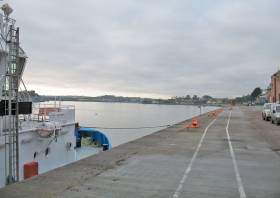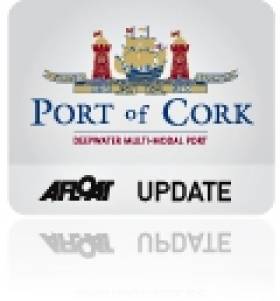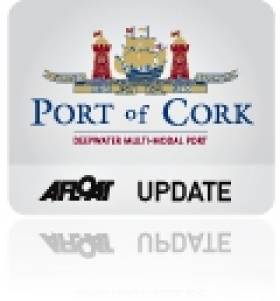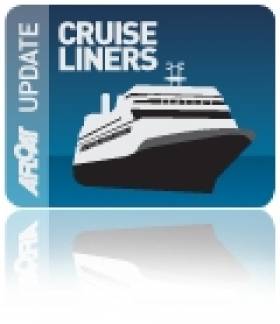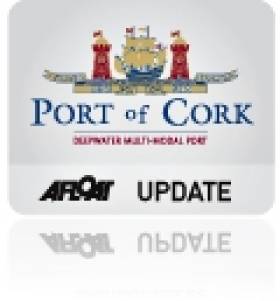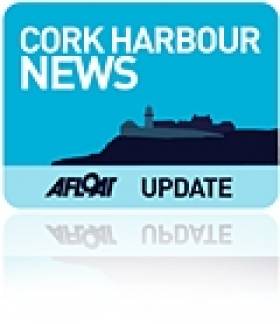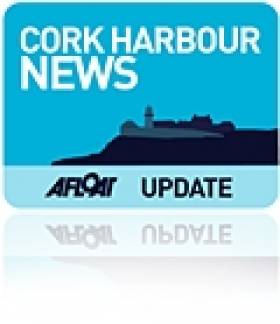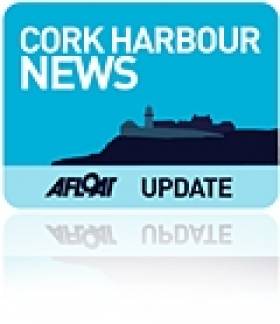Displaying items by tag: Port of Cork Company
Port of Cork Company Celebrates Bumper First Year at Cork Container Terminal
Over 90,000 containers were loaded and discharged at the Port of Cork Company’s new Cork Container Terminal (CCT) in Ringaskiddy in what was a bumper first year at the state-of-the-art facility.
The Cork Harbour terminal, which is the result of a €94 million investment, became operational in April 2022 with an official launch on 23 September 2022.
In its inaugural year, 46,932 containers were discharged at CCT and 48,282 containers loaded onto a total of 340 ships which docked at the deepwater facility. On average, 280 containers were loaded and discharged per ship.
Commenting on CCT’s first year in operation, Conor Mowlds, the Port of Cork Company’s chief commercial officer said: “The launch of CCT last year was a hugely important milestone for the Port of Cork Company as it marked the culmination of years of significant planning, investment and development in this vital facility to ensure the port’s ongoing competitiveness.
“CCT represents the largest single investment in marine infrastructure of any Irish port over the last 100 years and has enabled the port to deliver more efficient container handling facilities, strengthening Cork’s position as an international gateway for trade.”
The container terminal in Ringaskiddy is one of the largest deep-water, multimodal berths in the world at 13 meters deep and 360 metres long.
The official opening of CCT was followed by another significant milestone for the company in May this year with the launch of the Port of Cork Masterplan 2050, which will see further development of the CCT site.
Among the key points in the masterplan, the company says that the delivery of the M28 will enable further relocation of its activities from Tivoli Docks to Ringaskiddy and unlock significant port capacity in the lower harbour.
Supporting the accelerated growth of the fixed offshore renewable energy (ORE) sector is another important component of the plan which charts a course to a new sustainable and secure future for the port.
The Port of Cork Company has published its 2022 Annual Report, highlighting the opening of the new Cork Container Terminal in Ringaskiddy and its strong financial performance.
Turnover increased by 21.5% to €48.41 million in 2022 from €39.8 million in 2021 and the company’s profits also increased by 17.7%, with an operating profit of €9.16 million (€7.78 million in 2021).
The report shows a steady recovery from Covid-19 and growth despite ongoing global challenges.
In 2022, the Ports of Cork and Bantry reported a total consolidated traffic throughput of 10.2 million tonnes slightly lower than in 2021. The number of container 20-foot equivalent units (TEUs) increased slightly to 282,781 TEUs (281,816 TEUs in 2021), primarily as a result of the commencement of new Con-Ro services linking Ringaskiddy directly with Europe. Imports of trade cars and dry bulks also increased which all offset small declines in liquid and break bulk traffic.
Employment figures increased from 154 to 170 as a result of operating two container terminals at Tivoli and the new Cork Container Terminal in Ringaskiddy.
In April 2022, the cruise sector successfully recommenced and the Port of Cork welcomed a strong uplift in tourism trade with 82 cruise liner calls to Cork, carrying 115,000 visitors and nine cruise liner calls to Bantry. Brittany Ferries returned to normal pre-covid trading levels with 117,000 passengers and added a second weekly service from Cork to Roscoff.
The year will be remembered as a “monumental” one, the Port of Cork says, for the official launch of the €94-million Cork Container Terminal (CCT) in Ringaskiddy. This investment delivered an optimised 360m single berth, two new 50-metre Liebherr ship-to-shore cranes, additional straddle carriers, a new straddle carrier maintenance building, and new customs and excise facilities.
It also included a recreation area at Paddy’s Point and a new deepwater berth entrance and internal port roads network. The Port of Cork also doubled its container capacity by keeping the Tivoli Container Terminal fully operational.
Another key milestone in 2022 included the completion of a long-term Masterplan 2050 process including a full public consultation.
The final version of the Masterplan was launched by Minister for Transport Eamon Ryan and Minister for Finance Michael McGrath on Friday 19 May and it outlines the future port critical infrastructure required, as part of the port’s ‘river to sea port’ journey. The Masterplan also includes the port’s plans to facilitate the offshore renewable energy (ORE) Sector. The Port of Cork is currently the only port in Ireland with full planning permission in place for ORE infrastructure development.
‘We must continue to invest in port facilities to provide our customers with reliable, safe, high-performing facilities and services in an efficient logistics chain’
Conor Mowlds, chief commercial officer at the Port of Cork said: “This was a significant year for the port. Post-pandemic recovery was strong and growth progressed throughout many areas of the business. We took many strides towards our voyage into the future — most notably with the official launch of Cork Container Terminal and the publishing of our Masterplan 2050 which will chart our course over the next three decades.
“Following a strong financial year, we are now in a better position to progress vital additions to our infrastructure — including upgrades to our cargo handling fleet and port facilities.
“In addition, a key objective for the port moving forward is a focus on sustainability. The Port of Cork is very well positioned and ready to act as a key hub for Ireland’s move towards offshore renewables and at the same time support the journey to net-zero through our well-developed presence in transition fuels.”
Eoin McGettigan, chief executive officer of the Port of Cork Company added: “I would like to thank our customers, our team, extended network of suppliers and stakeholders, who underpinned another successful year at the port and who continue to keep Cork connected as part of the global supply chain.
“In 2022 we completed the first phase of our strategy, to open CCT and relocate operations downriver to address the challenge of ever-increasing vessel sizes and customer demand for quicker turnaround in port. Our 2023–2027 Corporate Strategy sets out the next steps involved in meeting capacity demands, including the requirement to continue dual operations at the Tivoli Container Terminal and CCT in the medium term, while we await the construction and operation of the M28 dual carriageway from the Bloomfield inter-change to Ringaskiddy.
“We must continue to invest in port facilities to provide our customers with reliable, safe, high-performing facilities and services in an efficient logistics chain. To fund this future we must drive increased efficiency in our business, make the right commercial decisions and consider all possible funding solutions.”
Click HERE to view or download a copy of the 2022 Annual Report from the Port of Cork website.
Port Of Cork Moves To Clarify Cobh Quay Closures After Gardai Called To ‘Right Of Way’ Protest
The Port of Cork has issued a “clarification” over its closures of the deepwater quay in Cobh after gardai were called to a recent protest at the facility.
The Irish Examiner reports that there was what gardai described as a “minor altercation” at the quay on the evening of Friday 3 May involving port security and ‘right of way’ protesters.
It’s claimed that one protester was injured while attempting to help a fellow demonstrator after an altercation.
The incident happened during the disembarking of the Celebrity Reflection cruise liner at the quay.
Demonstrators object to the port’s closure during cruise berthings of the quayside and its adjoining walkway, which they maintain has been a traditional right of way for more than 150 years.
But the Port of Cork Company has dismissed those assertions in a statement, saying that “despite erroneous claims to the contrary, Port of Cork Company is the freehold owner of Deepwater Quay” and that “no public right of way exists” over the quay.
“While the Port of Cork Company (and previously Cork Harbour Commissioners) have been willing to permit access by the public to Deepwater Quay, the port has always controlled such access where required in the interest son heath and safety, security and the smooth and safe management of shipping traffic.”
Port chief executive Brendan Keating acknowledged “challenges” facing the port as its cruise business has grown in recent years.
Among these are “high-risk” berthing operations involving multiple mooring lines.
“Like every port around the globe, the Port of Cork does not take risks, especially when it comes to the safety of employees, the public or visitors and for this very reason, the Port of Cork closes off the quay during arrival operations.
“The quay is normally closed for a period of approx 30 minutes and during this period the arriving shore excursion coaches are marshalled into into place while the quay is free of pedestrians, this reducing any risk of a traffic accident.”
The port company added that “it is by no means the intention of the port to obstruct members of the public from accessing the deepwater quay or to diminish the enjoyment gained by the public from observing such magnificent liners up close”.
Increase in Trade Traffic 2012 Levels for Port of Cork
#PortofCork- A total 9.05 million tonnes was recorded in trade traffic at the end of 2012, according to the Port of Cork Company. This is an increase of 2% compared to 2011 figures and it is the first time traffic figures in the port have surpassed 9 million tonnes since 2008.
2012 was a very challenging year across many sectors including the Irish port sector with the import of goods through Irish ports reported to have fallen by up to 11%. However, the Port of Cork container volumes has shown an increase of 6% with over 165,000 TEU handled during 2012 and imports, excluding oil, are up by 12%. Imports of animal feed stuffs increased by 58% compared to 2011 while fertiliser, cereals and other trades have shown a marginal decrease in 2012.
Oil traffic remained steady despite the lower levels of domestic economic activity; however exports of refined product from Phillips 66 Whitegate Oil Refinery were strong and continue to be a significant part of the Port of Cork business. Exports are a key driver in the successful recovery of the Irish Economy and the Port of Cork is committed to continuous support in the growth of international trade for the country's economic prospects and job creation.
Remarking on the end of year trade traffic results, Mr Brendan Keating, Chief Executive of the Port of Cork said: "The Port of Cork is pleased to announce that our total trade traffic in 2012 remained strong and overall we are starting to see some stabilisation in trade levels in and out of the Port. With 98% of volume of all goods imported or exported from Ireland moved by ship, the importance of ports to our economy is of vital strategic importance. We will continue to look to the sectors that are performing strongly, such as food exports and will seek to capitalise on the demand for such goods from Europe and emerging markets."
He continued: "The Port of Cork is a key link to the continued economic success of Ireland and in particular the entire Munster region. The challenge now facing us in 2013 is to continue to develop the Port in order to meet the needs of the Country as it emerges from this current recession. We will continue to be extremely active in the emerging trends and logistic supply changes to reinforce our existing strength as the primary deepwater port in the south of Ireland and build on our progress to date".
Port officials are pro-actively engaged with tourism interests, County and City Councils and destination attractions to enhance the product on offer to the visiting cruise lines with a view to growing the business further through its dedicated cruise terminal. 57 cruise vessels visited the Port of Cork during 2012 bringing almost 100,000 passengers and crew to the region and the Port is scheduled to accommodate 64 vessels in 2013.
The Port of Cork was awarded two Cruise Insight Awards for 'Best Shore Side Welcome' and 'Best Tour Guides' which were announced at the global shipping conference, Seatrade Miami in April 2012. This achievement highlighted the outstanding team effort and commitment by the Port of Cork to deliver an excellent service to the visiting cruise lines and their passengers when in Cork.
The Port is delighted to be supporting The Gathering for 2013 and is actively ensuring that all visitors who transit through our facilities receive a warm welcome to Irish shores. Brittany Ferries remained steady on its weekly ferry service from Cork to Roscoff and the Port remains fully committed to establishing new routes and services from Cork.
The Port of Cork's recreational strategy continues to expand with the aim of improving the marine leisure facilities around Cork Harbour.
Port of Cork Sees Signs of Recovery
#PORT OF CORK – The Munster port posted an operating profit before exceptional costs of €1.3 million – down by €700,000 from 2010 – on a turnover of €21.4 million. Port of Cork chairman Dermot O'Mahoney expressed satisfaction at the port's performance in 2011.
Traffic amounted to 8.8 million tonnes in 2011, which matched 2010 levels, with oil amounting to 4.96 million tonnes and non-oil traffic accounting for 3.4 million tonnes, according to Mr O'Mahoney. Oil traffic, handled mainly at Conoco Phillips Whitegate Oil refinery, was down 1 per cent on 2010 but non-oil traffic maintained the same level as 2010.
Container traffic in 2011 increased by 6 per cent to 156,667 TEUs (Twenty Foot Equivalent Unit). For more about Ireland's second biggest port in terms of containers handled, a report appeared in yesterday's Irish Times.
Cruise Europe Appoints Port of Cork Official
#CRUISE SHIP SECTOR – Cruise & Ferry reports that Captain Michael McCarthy of the Port of Cork Company was unanimously chosen to become the new chairman of industry association Cruise Europe.
At the association's conference held last month at Royal Greenwich, McCarthy was chosen to replace Dirk Moldenhauer, who held the role for the last four years.
With 40 years of maritime experience in positions as varied as master at sea, marine surveyor and deputy harbour master, McCarthy is currently commercial manager at the Port of Cork Company.
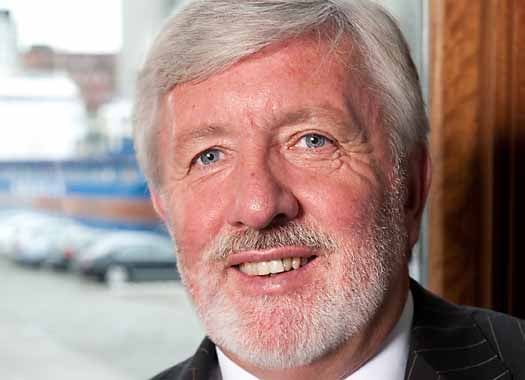
Captain Michael McCarthy is the new new chairman of industry association Cruise Europe
McCarthy thanked Moldenhauer for steering Cruise Europe through a modernization process and making it more professional and responsive to the requirements of its members. He said Cruise Europe's vision was "to deliver to the cruise companies a world class cruise destination on behalf of our members" and that he would continue working with members to promote and develop "must see" North and Atlantic European destinations.
He added: "We are facing major challenges and it is vital that Cruise Europe members support the cruise lines through greater communications and develop outstanding service while keeping costs tightly under control, particularly as the lines adapt to the Emissions Control Area regulations from 2015."
Port of Cork press release below:
PRESS RELEASE
Captain Michael McCarthy, Port of Cork, Elected as Chairman of Cruise Europe
Irish Cruise Line Business Worth an Estimated €60M to the Irish Economy
At the Cruise Europe Conference 2012 held at Royal Greenwich, London in April, Captain Michael McCarthy of the Port of Cork, was unanimously elected Chairman of Cruise Europe. Michael brings over 40 years of maritime experience to the position having served as Master at sea, Marine Surveyor, Deputy Harbour Master and is currently Commercial Manager with the Port of Cork Company.
Michael endorsed the vision of Cruise Europe which he said is "to deliver to the cruise companies a world class cruise destination on behalf of our members". Between 2005 & 2010, there has been an increase of 84% growth in the economic impact of the European Cruise Industry, bringing the total contribution to €35 billion.
On average there are over 200 cruise calls to Ireland per year carrying approximately half a million passengers and crew. This cruise business contributes an overall economic contribution estimated to be worth €60 million to the island of Ireland.
Commenting on the Irish cruise business, the newly elected chairman of Cruise Europe, Captain Michael McCarthy said: "There are many indirect economic and tourism benefits to Ireland from the cruise sector, as well as the benefit of introducing Ireland to new markets and growing business opportunities. Cruise visits help to showcase Ireland's world class shore products, destinations and highlight all that Ireland has to offer visitors."
He continued: "One of Ireland's advantages is the strategic and geographic spread of its numerous ports, many of which are in close proximity to world class tourism destinations and it is with this in mind that Ireland will be promoted with the North and Atlantic European destinations to develop thriving and "must see" destinations."
The cruise industry, as a whole, faces major challenges and it is vital that Cruise Europe members support the cruise lines through effective communications and develop an outstanding service while keeping costs tightly under control, particularly as the lines adapt to the ECA [Emissions Control Area] regulations from 2015.
"These regulations, which will come into force on January 1st 2015, will reduce sulphur limits in fuel to 0.10%. This will result in vessels operating from the English Channel through the North Sea into the Baltic from 2015, to have increased operating fuel costs of over 50%."
McCarthy also outlined the benefits of being a member of Cruise Europe and the commitment to working closely with the ECC and other representative organizations.
‘Resilient’ Performance by Port of Cork in 2011
#PORT OF CORK - Port of Cork Company chairman, Mr Dermot O'Mahoney, yesterday announced end of year trade traffic results for the Port of Cork in 2011. He said: "Trade traffic has shown remarkable resilience recording 8.8 million tonnes despite experiencing challenging periods during 2011." These figures are on a par with 2010 figures at the Port of Cork.
A remarkable feature of the figures is the very positive effect on the local economy by the increase in exports from the Port. Total exports at the Port of Cork have remained strong increasing by 9% in comparison to 2010 and by 19% since 2009. Exports are a key driver in the successful recovery of the Irish Economy and the Port of Cork is committed to continuous support in the growth of international trade for both current and future economic prospects.
Although the growth in export volumes to pre –recession levels reflects the rapid "V" shaped bounce back by the export sector which was achieved despite the depressed international economic environment, import volumes are still 12.9% below 2007 levels. The continued low volume of imports is inevitably putting huge strain on the ports, shipping lines and transport sector servicing the country.
The container business at the Port of Cork has shown an increase of 5% with over 150,000 TEU handled in 2011. Animal feed stuffs, fertiliser and other trades have shown a marginal decrease in 2011. Oil traffic has remained steady despite the lower levels of domestic economic activity; however exports of refined product from Conoco Phillips Whitegate Oil Refinery has remained strong and continues to be a significant part of the Port of Cork business.
Remarking on the end of year trade traffic results, Mr Dermot O'Mahoney Chairman of the Port of Cork said: "The Port of Cork is pleased to announce that total trade traffic in 2011 has remained strong with exports increasing by 9% over 2010 volumes. With 98% of all goods imported or exported from Ireland moved by ship, the importance of ports to our economy is of vital strategic importance. The Port of Cork is a key link to the continued economic success of Ireland and in particular the entire Munster region. The challenge now facing the Port of Cork is to continue to develop to meet the needs of the Country as it emerges from this current recession. This requires that we be visionary and seize opportunities presented by emerging trends and logistic supply changes."
He continued: "While the next four to five years will be challenging for us all, we need to continue to promote the fact that Ireland is an excellent investment location and is well placed to capitalise on growing global markets as is evident by our export sector."
53 cruise vessels visited the Port of Cork during 2011 bringing over 100,000 passengers and crew to the region and the Port is scheduled to accommodate 60 vessels in 2012. According to research carried out by UK Consultants GP Wild, the average in-transit spend per passenger, while visiting an Irish port is between €73- €100 which provides a significant contribution towards the local tourism economy. In 2011 the Port of Cork won 1st place for 'Best Destination Experience (Organised)' in the world and 2nd place for 'Best Port Welcome' in the Dream World Cruise Destinations Awards. This achievement highlighted the outstanding team effort and commitment by the Port of Cork to deliver an excellent service to the visiting cruise lines and their passengers when in Cork. Ireland Inc. also received a Commendation as a "Destination where the Quality and Professionalism of Tour Guides is considered outstanding".
Port officials are pro-actively engaged with tourism interests, County and City Councils and destination attractions to enhance the product on offer to the visiting cruise lines with a view to growing the business further through its dedicated cruise terminal.
Ferry passenger numbers with Brittany Ferries remained steady on its weekly ferry service from Cork to Roscoff and the Port awaits the outcome of the Examinership of Fastnet Lines and the re-commencement of the ferry service linking Cork with Swansea.
The Port of Cork's recreational strategy continues to expand with the aim of improving the marine leisure facilities around Cork Harbour.
Mr O' Mahoney concluded by saying that "the Port of Cork must continue to reinforce its existing strength as the primary deep-water port in the south of Ireland and build on our progress so far by effectively resolving our challenges in an imaginative way and with a strong sense of urgency and determination."
Road, Rail or ‘Sail’ to Cobh
There's also the option of departing Cork-city centre to Cobh by taking an excursion on the River Lee on the passenger-tender Spirit of the Isles. Sailings depart the city's Penrose Quay, which is on the same side to the railway (Kent) station.
Sailings will operate this Saturday and Sunday and for the remaining weekends throughout September. The boat's Saturday schedule departs the city at 11am and arrives at Cobh's Kennedy Quay at 12.15pm.
In addition there is a Lower harbour tour off Cobh on Saturdays and Sundays, departing Kennedy Pier, Cobh - 12.30pm and returning to Kennedy Pier at 1.45pm. The boat then departs Cobh at 2pm to return to Cork with an arrival time of 3.15pm. For both this Saturday and Sunday sailing schedules, fares and further information go to www.corkharbourcruises.com
In the late 1980's the Spirit of the Isles then named Ingot operated excursions for several seasons from Dun Laoghaire's East Pier to Dalkey Sound and Killiney Bay.
Returning to the third annual Cork Harbour Open Day there will also be a free shuttle-service running in the lower harbour calling at Ringaskiddy, Monkstown, Cobh, Aghada and Crosshaven. The fast-ferry RIB operator 'Whale of a Time' is providing the free service which is sponsored by the Port of Cork Company and National Maritime College of Ireland (NMCI). For further information visit http://www.whaleofatime.net/Home.html
- Dun Laoghaire
- Cork Harbour
- port of Cork
- Cruise Liners
- River Lee
- Cork Harbour Open Day
- NMCI
- Cobh Cruise Terminal
- National Maritime College of Ireland (NMCI)
- Ports and Shipping News
- Cork Harbour News
- Irish Rail
- Port of Cork Company
- Cunard Line
- Queen Elizabeth
- Whale of a Time
- Cruise Liner news
- Dalkey Sound
- Cruise ship news
- Midelton Food & Drink Festival
- Ingot
- Killiney Bay
- Irish passenger excursion vessels
- Cork Harbour Cruises
- CorkCobh
- Cork (Kent) station
- Spirit of the Isles
Take a View From the Bridge
In the evening the Cork Corona Film Festival will hold a fundraiser themed the 'Amazing Cork Maritime Experience' at the NMCI from 5pm onwards.
Also in Ringaskiddy, at the Deepwater Quay, Fastnet Lines' 22,000 tonnes Julia will be open to the public between 11am to 3pm. This will allow those to tour the facilities of the 1,500 passenger/325 vehicle capacity ferry which has operated the year round Cork-Swansea route since last year.
To enable visitors to visit the events spread across the world's second largest natural harbour, a free shuttle-ferry service connecting Ringaskiddy, Monkstown,Cobh, Aghada and Crosshaven will be operating on the day. The ferry service is sponsored by the Port of Cork Company and National Maritime College of Ireland (NMCI).
- port of Cork
- Cork Harbour Open Day
- NMCI
- Fastnet Line
- National Maritime College of Ireland (NMCI)
- Ports and Shipping News
- Cork Harbour News
- Port of Cork Company
- Ferry news
- Portsand Shipping News
- Irish nautical college
- MVJulia
- Ringaskiddy Ferry Terminal
- CorkSwansea ferry route
- Cork Corona Film Festival
Countdown to Cork Harbour Open Day
This will be the third Cork Harbour Day which is to cover a wide range of events, such as concerts on Spike Island, a photographic exhibition in Camden Fort, guided tours of an Irish naval ship at Cork City Quays and an open day at the National Maritime College of Ireland (NMCI).
In addition Fastnet Line's ferry Julia will be open for the public to board. The 22,161 gross tonnes serves the Cork-Swansea route and for the Open Day she will be berthed at Ringaskiddy Deepwater Berth instead of the nearby ferry terminal. To read details of Open day programme visit www.corkharbour.ie and updates click HERE.
The concept for the Harbour Open Day emerged three years ago, which combined various stakeholders involved in the development and implementation of the Integrated Strategy for Cork Harbour. A group comprising of representatives from UCC, City and County Councils, the Naval Service and the Port of Cork set about working together to engage with users of the harbour and to organise the Open Day.
Cork Harbour is the second largest natural harbour in the world, next to Sydney Harbour, offering beautiful locations for enjoying the outdoors, dramatic coastlines, and excellent leisure facilities, and is home to some very talented artists, sportsmen and women, and people who are passionate about the history, heritage and cultural value of Cork Harbour.
- Spike Island
- Cobh
- Cork Harbour
- naval service
- National Maritime College of Ireland
- port of Cork
- Cruise Liners
- Cork Harbour Open Day
- NMCI
- Ports and Shipping
- Cobh Cruise Terminal
- Cork Harbour News
- Cunard Line
- Queen Elizabeth
- Cruise ships
- Cork City Quays
- Camden Fort
- Port of Cork Company
- Ringaskiddy Deepwater Terminal



























